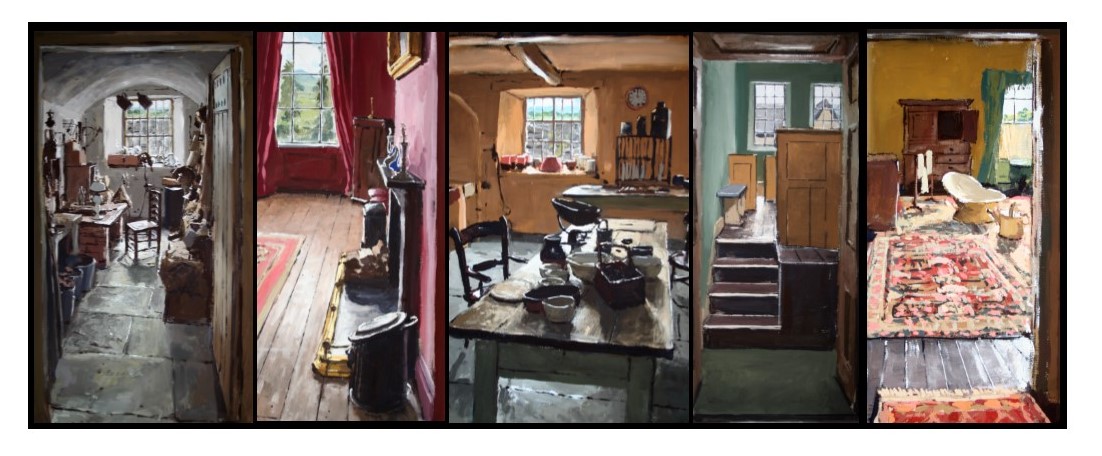The name given to the tight trousers worn by some Regency gentlemen, such as the notorious Beau Brummell and his ‘dandy’ followers, as they showed off their leg muscles.
Ethiopian Emperor’s shield causing excitement
PRESS RELEASE



The Judge’s Lodging is very excited to discover that a young museum conservator, who recently worked on a project with them, has been shortlisted to the final four of the much-contested Student Conservator of the Year Award. Gemma McBader of Cardiff University chose to work on one of The Judge’s Lodging’s community collections items – a rather worn shield, listed in the old Presteigne Museum records from 1980 as a ‘Tuareg shield with spear’. Little was known about these items, other than they had come as a donation from the Rennell- Rodd family, who lived at the Rodd, on the edge of town. They were given to the old Presteigne & District Museum, which was housed at the time in the basement of the the old Shire Hall (now known as The Judge’s Lodging).
Once the shield arrived in Cardiff for Gemma to start her project, to research and restore the shield, she called the museum to say that it was not from the Tuareg people (nomadic people of the Sahara) but an Ethiopian Emperor’s shield. She searched through other museum collections throughout Britain to find similar ones, including the British Museum and the huge ethnographic collection at the Pitt Rivers Museum in Oxford, and discovered not only that she was right, but that this one was quite unique in its colouring and decoration to others now in the UK. It was already known that the shield had belonged to Sir James Rennell Rodd, the British diplomat who lived just outside Presteigne. Gemma’s painstaking research so excited the staff at The Judge’s Lodging, though, when she identified the precise moment when it was presented to Sir James, by Emperor Menelik II on the signing of the 1897 Anglo-Ethiopian Treaty.
Not only has the Judge’s Lodging had the shield returned safely to its collection with stunning work by this young conservator, but it has in the process discovered that something that sat in a store for years in fact has a real special significance to Anglo- Ethiopian relations over 100 years ago!
And what of the spear, that it was once displayed with, in the small town museum? Well, that’s just arrived back in Presteigne, after being featured in an exhibition about the Tuareg people of the Sahara at the Royal Geographical Society in Kensington! The spear, which was gifted to the old museum at the same time as the shield, belonged to Sir James’ son Francis, a Senior Intelligence Officer, who studied the Tuareg and wrote ‘People of the Veil’, one of the greatest works on the Sahara region and its people. Sir Francis was President of the Royal Geographical Society and The Judge’s Lodging was delighted to be able to lend one of his personal items for display there.
The Student Conservator of the Year Awards will be announced in October and all fingers are crossed in Presteigne that Gemma’s work will shine through. Both the shield and spear will go on display in the community exhibition gallery at The Judge’s Lodging this autumn. Do go down and see these remarkable objects for yourselves.
You can find out more about Emperor Menelik II at the British Museum’s website – they’ve got a lovely portrait of him too: http://www.britishmuseum.org/explore/highlights/highlight_objects/aoa/e/emperor_menelik_ii,_painting.aspx
You can discover more about the ICON Conservation Awards here: http://conservationawards.org.uk/awards/
There is plenty of information about Sir James Rennell Rodd here: https://en.wikipedia.org/wiki/Rennell_Rodd,_1st_Baron_Rennell
Please do contact me on info@judgeslodging.org.uk or call 01544 260650 to ask for any further details.
Gaby
Gabrielle Rivers
Senior Museum Curator
The Judge’s Lodging
Presteigne
Powys
LD8 2AD
Tel: 01544 260650
Email: info@judgeslodging.org.uk
Don’t forget to follow us on Facebook: www.facebook.com/TheJudgesLodging
